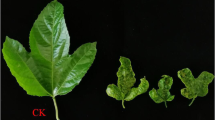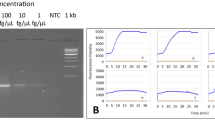Abstract
The unavailability of adequate immunological reagents has prevented the use of ELISA for the diagnosis of rupestris stem pitting disorder of grapevines. In this work, the performance of five primer pairs for broad-scale detection of rupestris stem pitting associated virus-1 by RT-PCR using ds-RNA templates was compared and contrasted with biological indexing. The virus was widespread among the budwood of 35 Portuguese grapevine varieties assayed, with a prevalence of 85%. The biological assay proved to be unreliable as an index of infection due to the high number of false negatives. Five sets of primers were assayed and compared by means of their relative sensitivity and negative predictive value. The primer pair specific for the coat protein gene was excluded because of the difficulty in identifying the specific amplified product. From the other four primer pairs, those specific for the helicase domain of the putative polymerase gene had the highest sensitivity and negative predictive value. However, a high confidence in the assay, as desirable for a certification scheme, could not be obtained by the sole use of this primer pair. An additional pair should be used in a separate or in a multiplex RT-PCR reaction.
Similar content being viewed by others
References
Azzam OI and Gonsalves D (1991) Detection of ds-RNA in grapevines showing symptoms of rupestris stem pitting disease and variabilities encountered. Plant Disease 75: 960–964
Boscia D, Minafra A and Martelli GP (1997) Filamentous viruses of grapevine: putative trichoviruses and capilloviruses. In: Monette PL (ed) Filamentous Viruses of Woody Plants. pp 19–28 Research Signpost, Trivandrum, India
Credi R (1997) Characterization of grapevine rugose wood disease sources from Italy. Plant Disease 81: 1288–1292
Garau R, Cugusi M, Dore M and Prota U (1985) Investigations on the yield of "Monica" and "Italia" vines affected by legno riccio (stem pitting). Phytopathologia mediterranea 24: 64–67
Hu JS, Gonsalves D and Teliz D (1990) Chraracterization of clostero virus-like particles associated with grapevine leafroll disease. Journal of Phytopathology 128: 1–14
MacKenzie DJ, McLean MA, Mukerji S and Green M (1997) Improved RNA extraction from woody plants for the detection of viral pathogens by reverse transcription-polymerase chain reaction. Plant Disease 81: 221–226
Martelli, G.P. (1993) Rugose wood complex. In: Martelli GP (ed) Graft-Transmissible Diseases of Grapevines, Handbook for Detection and Diagnosis (pp 45–54) FAO, Rome
Meng B, Pang S-Z, Forsline P, McFerson JR, Gonsalves D (1998) Nucleotide sequence and genome structure of grapevine rupestris stem pitting associated virus-1 reveal similarities to apple stem pitting virus. Journal of General Virology 79: 2059–2069
Meng B, Johnson R, Peressini S, Forsline PL and Gonsalves D (1999) Rupestris stem pitting associated virus-1 is consistently detected in grapevines that are infected with rupestris stem pitting. European Journal of Plant Pathology 105: 191–199
Minafra A, MacKenzie DJ, Casati, Bianco P, Saldarelli P and Martelli GP (1997) Detection of an unusual RNA in grapevines indexing positive for rupestris stem pitting. In: Extended abstracts 12th Meeting ICVG, Lisbon, Portugal, 29 September-2 October, (p 43)
Monette PL, James D and Godkin SE (1989) Double stranded RNA from rupestris stem pitting-affected grapevines. Vitis 28: 137–144
Savino V, Boscia D, Musci D and Martelli GP (1985) Effect of legno riccio (stem pitting) on 'Italia' vines grafted onto rootstocks of different origin. Phytopathologia Mediterranea 24: 68–72
Schachter J (1997) Evaluation of diagnostic tests-special problems introduced by DNA amplification procedures. In: Lee H, Morse S and Olsvik O (eds) Nucleic Acid Amplification Technologies-Application to Disease Diagnosis, pp 165–169 Eaton Publishing.
Walter MH and Cameron HR (1991) Double stranded RNA isolated from grapevines affected by rupestris stem pitting disease. American Journal of Enology and Viticulture 42: 175–179
Zhang Y-P, Uyemoto JK and Kirkpatrick BC (1998a). A small scale procedure for extracting nucleic acids from woody plants infected with various phytopathogens for PCR assay. Journal of Virological Methods 71: 45–50
Zhang Y-P, Uyemoto, Golino D and Rowhani A (1998b). Nucleotide sequence and RT-PCR detection of a virus associated with grapevine rupestris stem-pitting disease. Phytophatology 88: 1231–1237
Author information
Authors and Affiliations
Rights and permissions
About this article
Cite this article
Nolasco, G., Mansinho, A., Santos, M.T. et al. Large Scale Evaluation of Primers for Diagnosis of Rupestris Stem Pitting Associated Virus-1. European Journal of Plant Pathology 106, 311–318 (2000). https://doi.org/10.1023/A:1008748924494
Issue Date:
DOI: https://doi.org/10.1023/A:1008748924494




